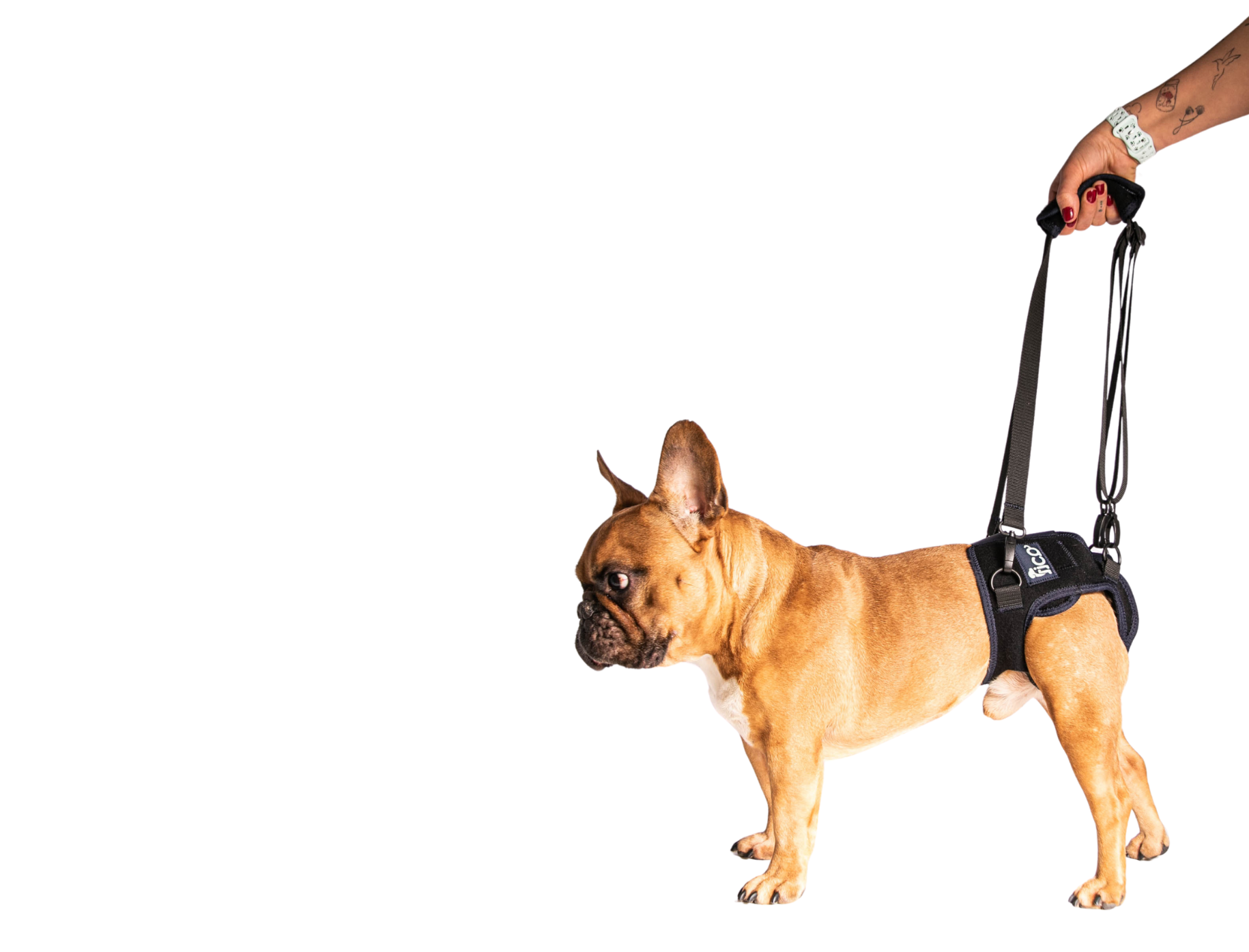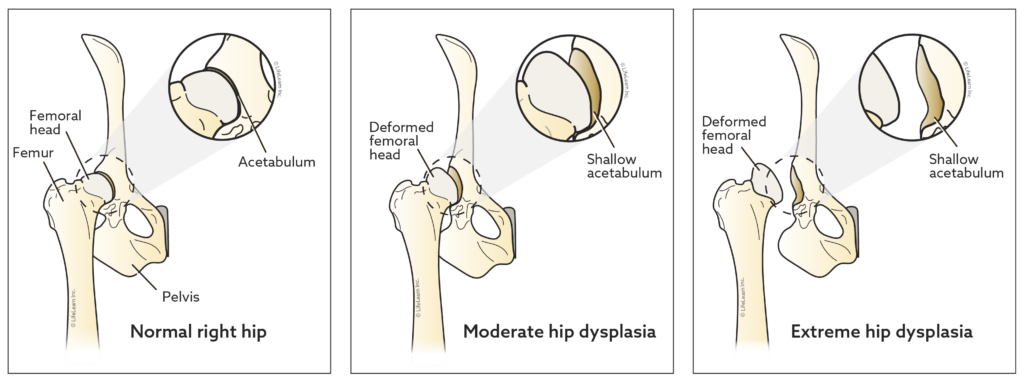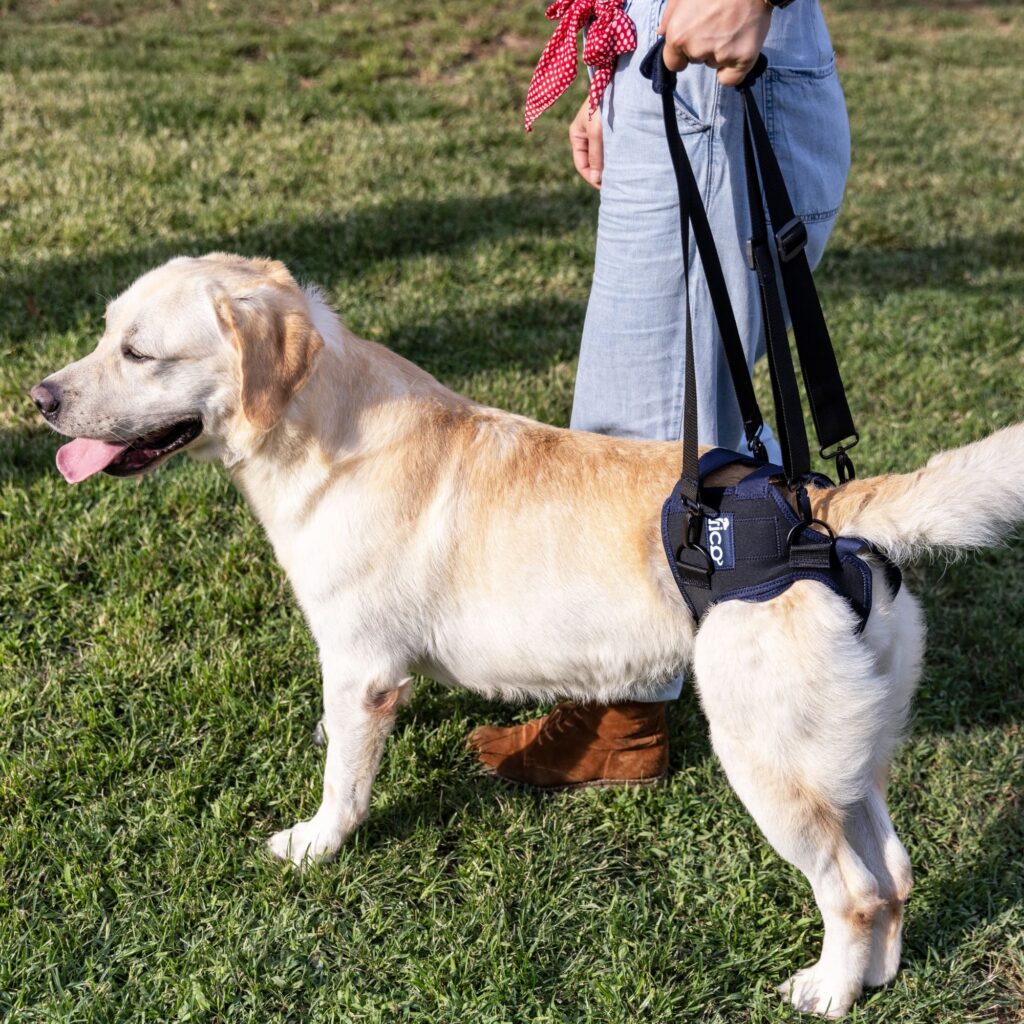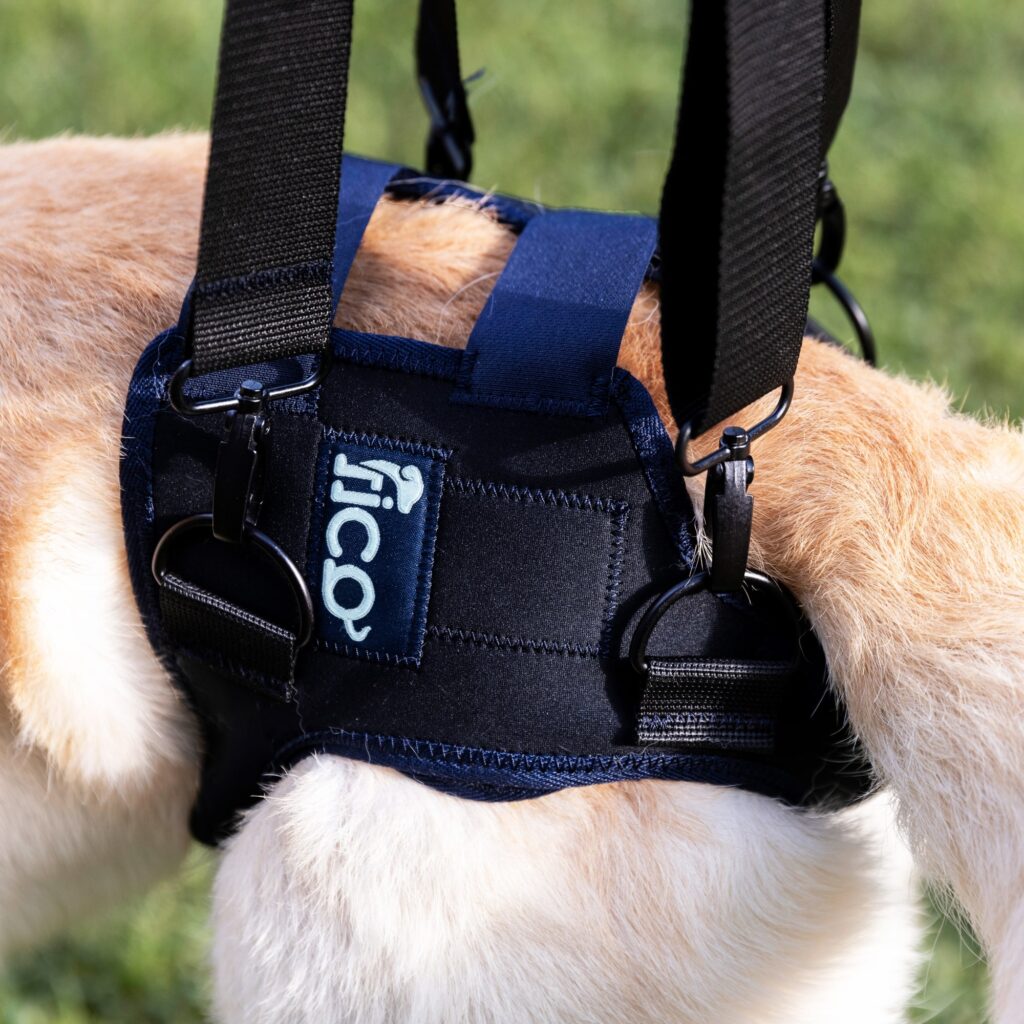Hip Dysplasia in Dogs: Causes, Symptoms, Treatment, and How Braces Can Help

What Is Hip Dysplasia in Dogs?
Hip dysplasia in dogs is a common skeletal condition that affects the proper development of the hip joint. Normally, a dog’s hip joint should function like a smooth ball-and-socket system. However, with hip dysplasia, the joint becomes loose or malformed, causing the bones to grind instead of glide smoothly. Over time, this leads to pain, inflammation, and even arthritis.
Canine hip dysplasia is especially prevalent in larger breeds, but it can affect dogs of any size or age. Genetics play a big role, though rapid weight gain, poor diet, or excessive exercise during puppyhood can also increase the risk. You might notice symptoms like stiffness, limping, or a reluctance to jump or climb stairs.
Early detection is key to managing the condition and maintaining your pup’s quality of life. Treatments range from bracing and physical therapy to medication and, in severe cases, surgery. Regular vet checkups can help catch and manage canine hip dysplasia early on.
What Causes Hip Dysplasia in Dogs?
If you’re wondering what causes hip dysplasia in dogs, the answer is often a mix of genetics and environmental factors. Genetics is the leading contributor, dogs born to parents with hip dysplasia are much more likely to develop the condition themselves. However, it’s not just about DNA.
Rapid growth during puppyhood can put excessive strain on developing joints. Combined with a poor diet that lacks balanced nutrients, this can weaken the bones and cartilage. Over-exercising young puppies, especially with high-impact activities, is another one of the common risk factors for hip dysplasia. All these factors can contribute to the abnormal development of the hip joint, eventually leading to discomfort and mobility issues.
By understanding what causes hip dysplasia, dog owners can take preventive steps, like managing diet, ensuring moderate exercise, and choosing breeds with healthier genetic lines when possible.

Symptoms of Hip Dysplasia in Dogs
Recognizing the symptoms of hip dysplasia in dogs early can make a big difference in your pet’s comfort and mobility. While the signs may vary depending on the dog’s age and the severity of the condition, there are some common red flags to watch for.
In puppies, hip dysplasia symptoms might appear subtly as they grow:
- Bunny hopping when running (both back legs move together)
- Reluctance to run, jump, or climb stairs
- Awkward or unsteady gait
In adult or senior dogs, signs tend to be more obvious due to joint deterioration:
- Difficulty standing up or lying down
- Limping or favoring one leg
- Pain when touched near the hips
- Decreased activity or reluctance to exercise
- Loss of muscle mass in the hind legs
Some dogs may also show stiffness, especially after resting or during cold weather. These signs can gradually worsen if left untreated. Since dogs often hide pain well, subtle changes in behavior or movement should not be ignored. If you notice any of these symptoms, it’s important to consult your vet for a proper diagnosis and treatment plan to help manage the condition and improve your dog’s quality of life.
How Is Hip Dysplasia Diagnosed in Dogs?
Diagnosing hip dysplasia in dogs starts with a thorough veterinary physical exam. Your vet will evaluate your dog’s range of motion, look for signs of pain or stiffness, and observe how they walk and stand. Gait analysis is often used to detect irregular movement, like limping or bunny hopping.
To confirm the condition, X-rays are typically required. These images give a clear view of the hip joints and can reveal any malformation or degeneration. In some cases, sedation may be needed to get accurate results. Early diagnosis is key to managing pain and slowing joint damage. If you suspect your dog is showing symptoms, don’t wait, diagnosing hip dysplasia in dogs early can make all the difference in treatment and long-term care.

Treatment Options for Hip Dysplasia in Dogs
When it comes to treating hip dysplasia in dogs, there are both non-surgical and surgical options available, depending on the severity of the condition and your dog’s overall health.
Non-surgical treatments are often the first line of defence, especially for mild to moderate cases. These can include:
- Weight management to reduce stress on the joints
- Anti-inflammatory medications to relieve pain and swelling
- Joint supplements like glucosamine and chondroitin
- Physical therapy to strengthen muscles and improve mobility
- Orthopedic dog braces, which offer non-invasive support and stability to the hip joint, allowing your dog to move more comfortably and with less pain. These braces are especially useful for dogs that aren’t good candidates for surgery or for pet parents seeking a conservative approach.
Surgical options are considered for more severe cases or when non-surgical methods fail. Common procedures include:
- Femoral Head Ostectomy (FHO) – removal of the femoral head to reduce pain
- Double or Triple Pelvic Osteotomy (DPO/TPO) – realigning the hip socket in younger dogs
- Total Hip Replacement – replacing the damaged joint with an artificial one for long-term relief
Choosing the right treatment for hip dysplasia in dogs depends on many factors. Consulting with your veterinarian is crucial to determine the best path to help your furry friend live a more comfortable and active life.
How Dog Braces Help Hip Dysplasia
Orthopedic dog braces for hip dysplasia have become a game-changer for pet parents looking for non-surgical, supportive solutions for dogs with hip dysplasia. These braces are designed to provide targeted support to the hip joint, helping dogs regain mobility, reduce pain, and enjoy a more active lifestyle.
One of the primary benefits of dog braces for hip dysplasia is pain reduction. The brace gently compresses and supports the joint, easing the strain on the hip and surrounding muscles. This can significantly lower discomfort during movement, especially in dogs suffering from inflammation or joint instability.
Another major advantage is joint stabilization. When the hip joint is loose or malformed, every step a dog takes can cause the bones to grind and wear down the cartilage. A well-designed brace helps to keep the joint properly aligned, minimizing this damaging motion and preventing further degeneration.
Dog braces also offer mobility support, allowing dogs to walk, run, and play with greater confidence. For senior dogs or those recovering from injury or surgery, these braces can dramatically improve their quality of life. They’re especially beneficial for dogs who are not candidates for surgery due to age, weight, or other health conditions.
Many pet owners have shared positive experiences using these braces. Fico has had the privilege of helping many dogs with hip dysplasia regain supported mobility, bringing renewed comfort and freedom of movement. This not only restores joy to the dog but also brings peace of mind and happiness to their owners. Clinical insights also support these results, showing that regular use of hip braces can improve a dog’s gait and reduce reliance on pain medication. Fıco’s Hip Dysplasia Brace is highly effective for various degrees of dysplasia and hip arthrosis, providing an excellent alternative to hip surgery in many cases. It includes removable padding discs for added compression and stiffness, which reduce pain by exerting bilateral compression on the hips.
Veterinarians often recommend orthopedic dog braces as part of a broader management plan. When combined with weight control, supplements, and moderate exercise, they can significantly slow the progression of the disease and extend a dog’s mobility over time.
In short, supportive solutions for dogs with hip dysplasia like orthopedic braces are a safe, effective, and non-invasive option that give dogs the comfort and freedom they deserve. They’re not just for temporary relief, they can be a long-term part of your dog’s care plan, offering daily support where your pup needs it most

Surgical Options for Hip Dysplasia in Dogs
When non-surgical treatments no longer provide relief, surgical options for hip dysplasia in dogs may be recommended by your veterinarian. These procedures are typically considered in moderate to severe cases or when a dog’s pain and mobility issues significantly impact daily life.
Total Hip Replacement (THR) is the most comprehensive surgical option. It replaces the damaged hip joint with an artificial one, offering long-term pain relief and restored mobility. Femoral Head Ostectomy (FHO) involves removing the head of the femur to eliminate bone-on-bone contact, creating a “false joint” that helps reduce pain. Double or Triple Pelvic Osteotomy (DPO/TPO) is usually performed on younger dogs before arthritis sets in and involves realigning the hip socket for a better fit.
Recovery times vary, but most dogs need several weeks of rest and physical therapy. With proper care, many dogs regain excellent function and enjoy a more active, pain-free life.
Can You Prevent Hip Dysplasia in Dogs?
While not always completely avoidable, there are ways to reduce the risk and better understand how to prevent hip dysplasia in dogs. Early screening is key, especially in breeds prone to the condition, so vets can monitor joint development from a young age. Choosing a reputable breeder who tests for hip health is also crucial when it comes to breed selection.
Providing proper nutrition during puppyhood helps support healthy bone growth. Supplements like glucosamine and omega-3 fatty acids can also promote joint health over time. Avoid over-exercising puppies, as their joints are still developing. Instead, stick to controlled, low-impact activities that build strength without strain.
Taking these preventive steps early on can make a big difference in minimizing the chances of hip dysplasia and ensuring your pup leads a healthier, more mobile life.
Prognosis: Can Dogs Live Comfortably with Hip Dysplasia?
Yes, many dogs can live comfortably with hip dysplasia, especially when the condition is properly managed. The prognosis varies depending on the severity of the dysplasia and the treatment options chosen, but with the right care, dogs can still lead long, happy lives. In fact, the dog hip dysplasia life expectancy is often unaffected when the condition is treated early and effectively.
Living with hip dysplasia in dogs without treatment, however, can lead to chronic pain, reduced mobility, and a significant decline in quality of life. Over time, the condition can worsen, making even basic movements difficult. That’s why early intervention is so crucial. One of the best ways to help your puppy live a full and happy life is by restoring their mobility with a hip dysplasia brace. These braces have been shown to significantly improve movement, allowing dogs to walk, run, and play more comfortably.
With proper treatment, whether it’s weight management, medication, physical therapy, or orthopaedic dog braces, many dogs show noticeable improvements. Braces, in particular, help support the joint, reduce pain, and restore mobility without surgery. In more severe cases, surgical procedures can be life-changing, allowing dogs to regain function and reduce discomfort dramatically.
Ultimately, dogs with hip dysplasia can enjoy a high quality of life with the right mix of medical support, home care, and regular veterinary monitoring. It’s not about just extending their years, it’s about making those years active, comfortable, and joyful.
Hip dysplasia in dogs can be a challenging condition, but with the right knowledge and care, it’s manageable. From understanding early symptoms to exploring treatment options like physical therapy, surgery, or dog braces for hip dysplasia, proactive action can make all the difference. Key takeaways? Early detection, consistent vet care, proper diet, and mobility support are essential in giving your pup the best life possible.
If you notice any signs like limping, stiffness, or difficulty standing, don’t wait—contact your veterinarian for a proper diagnosis. And for non-invasive, supportive solutions, check out Fico’s custom orthopedic dog braces. They’re designed to reduce pain, improve stability, and help your dog move comfortably again.



